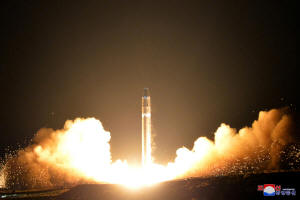Factbox-The 'monster missile' that may be involved in N.Korea's biggest
ICBM test
 Send a link to a friend
Send a link to a friend
 [March 24, 2022]
SEOUL (Reuters) - North Korea conducted what would be its largest
intercontinental ballistic missile (ICBM) test ever on Thursday,
according to South Korea and Japan, bringing new attention to a massive
new missile that may be under development. [March 24, 2022]
SEOUL (Reuters) - North Korea conducted what would be its largest
intercontinental ballistic missile (ICBM) test ever on Thursday,
according to South Korea and Japan, bringing new attention to a massive
new missile that may be under development.
North Korea has not confirmed what missile was involved in the test, but
it came after officials in Seoul and Washington said launches on Feb. 27
and March 5 involved parts of the Hwasong-17 ICBM system, likely in
preparation for eventually conducting full test like the one on
Thursday.
The unknown missile on Thursday was reported to have flown for 71
miuntes to a maximum altitude of 6,200 km (3,853 miles) and a range of
1,080 km (1,738 miles). That is further and longer than North Korea's
last ICBM test in 2017, when it launched a Hwasong-15 missile that flew
for 53 minutes to an altitude of about 4,475 km and range of 950 km.
Here's what we know the Hwasong-17, which analysts have called a
"monster missile":

North Korea first unveiled the previously unseen ICBM at an
unprecedented predawn military parade in October 2020, with analysts
noting it appeared "considerably larger" than North Korea's last new
ICBM, the Hwasong-15, which was test fired in November 2017.
It was displayed a second time at a defence exhibition in Pyongyang in
October 2021. After examining photos of the exhibit, analysts concluded
the official designation of this large ICBM is most likely “Hwasong-17”,
not Hwasong-16.
[to top of second column]
|

A view of the newly developed intercontinental ballistic rocket
Hwasong-15's test that was successfully launched is seen in this
undated photo released by North Korea's Korean Central News Agency (KCNA)
in Pyongyang November 30, 2017. REUTERS/KCNA/File Photo
 It is unclear whether the Feb. 27
and March 5 test-fires used all or part of the two-stage missile.
Some analysts say the tests may have involved only one stage.
The Hwasong-17, which has been shown on a transporter vehicle with
11 axles, would be one of the largest road-mobile ICBMs in the world
if it becomes operational.
Its diameter is estimated to be between 2.4 and 2.5 metres, and its
total mass, when fully fuelled, is likely somewhere between 80,000
and 110,000 kg, according to 38 North, a U.S.-based programme that
monitors North Korea.
The Hwasong-17's size has prompted analysts to speculate that it
will be designed to carry multiple warheads and decoys to better
penetrate missile defences. Some observers said that the satellite
technology that North Korea claimed to have tested in the two
launches could also be used for a multiple independently targetable
reentry vehicle (MIRV) system, potentially allowing a single missile
to drop nuclear warheads on different targets.
(Reporting by Josh Smith; Editing by Nick Macfie)
[© 2022 Thomson Reuters. All rights
reserved.] This material may not be published,
broadcast, rewritten or redistributed.
Thompson Reuters is solely responsible for this content.
 |